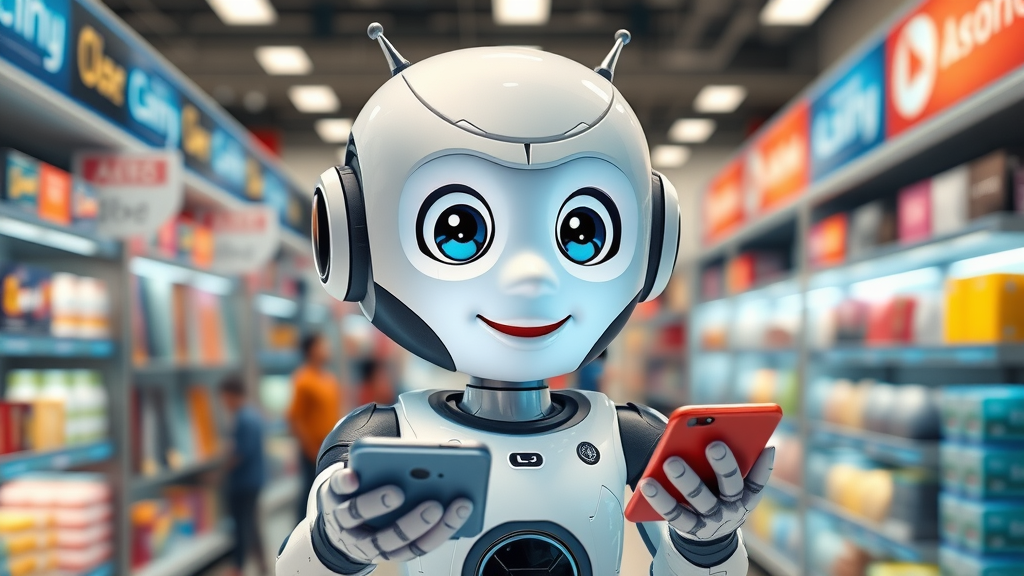Did you know that 83% of marketers saw their engagement rates double after implementing AI content personalization in 2024? This striking statistic isn’t just a number—it’s a wakeup call for every marketer still relying on traditional methods. AI content personalization has evolved far beyond simple segmentation. Today, it’s revolutionizing how brands communicate, build relationships, and engineer experiences that feel tailored for every individual. In this article, we’ll unlock the secrets of AI personalization, show you how to master the tools behind it, and guide you past ethical and technical pitfalls—arming you with everything you need to become a leader in modern marketing. Ready to transform your strategy? Let’s dive in.
AI Content Personalization: A Paradigm Shift in Modern Marketing
AI content personalization isn’t just an industry trend; it’s a fundamental shift in how businesses approach customer engagement. In the past, mass messaging and generic campaigns dominated the marketing scene, often leading to uninspired customer interactions and wasted resources. Today, AI-driven tools allow marketers to analyze customer data points like browsing behavior, past purchases, and even social media activity, transforming these insights into highly relevant content for every customer touchpoint. The result is an engaging, one-to-one experience that builds customer loyalty and drives powerful business outcomes .
This paradigm shift is about much more than algorithms and automation. Brands using generative AI and ai persona technologies can now create, test, and deliver content at a scale and sophistication once thought impossible. Imagine a world where a new customer receives an introductory email featuring only products or services related to their browsing habits, while a returning customer sees new product recommendations reflecting their evolving preferences and behavior. These capabilities are now a necessity , raising the bar for all marketers and demanding that personalization is considered at every stage of the customer journey .

- In 2024, 83% of marketers report that AI content personalization has doubled their engagement rates—challenging traditional marketing conventions and raising the bar for personalized experiences.
What You’ll Gain from Mastering AI Content Personalization
- Understand core concepts of generative AI and AI personalization
- Master techniques to enhance customer experience and customer journey
- Explore real-world case studies of powered personalization
- Assess the legal and ethical dimensions of AI content
- Access strategies for better marketing campaigns and customer interaction

Generative AI: The Engine Behind AI Content Personalization
To understand modern AI content personalization , you must appreciate the power of generative AI . These powerful AI technologies use advanced machine learning models to analyze vast quantities of customer data , including preferences and behavior, location, and even mood inferred from social feeds. By crunching millions of data points in real time, generative AI creates personalized emails, landing pages, and social media posts for each individual user . The speed and precision of these ai tools redefine what is possible in personalized engagement.
Brands leveraging generative AI find that even complex customization—down to dynamic web experiences and individualized product recommendations —become scalable. Not only does this improve the overall customer experience , but it also dramatically boosts ROI by ensuring that every interaction feels relevant, timely, and authentic. With so much potential, mastering generative AI is now essential for any marketing team serious about success in 2024 and beyond.
How Generative AI Drives Content Personalization at Scale
Generative AI tailors content by identifying patterns in customer behavior and interaction history, then adapting messaging and offers in near real-time. Whether the touchpoint is an email marketing campaign, a landing page, or a social media ad, generative AI ensures every experience resonates with the customer’s current needs and interests. Marketers can now run hundreds of campaigns at once, each uniquely crafted for specific ai persona profiles, maximizing customer engagement and conversion.
Consider the impact of dynamic web content: With generative AI, banners, featured products, and even editorial content adjust instantly based on each user’s history, device, and past interactions. This not only increases the relevance of the user experience but also fosters connection and loyalty by recognizing and responding to customers as unique individuals. In essence, generative AI brings marketing personalization to life at a scale that was unthinkable a decade ago.
From Data to Delight: Real-World Examples of AI Personalization
AI personalization breakthroughs are everywhere—from e-commerce giants providing relevant product suggestions to streaming services perfectly tailoring content feeds. Netflix’s recommendation engine, for example, accounts for over 80% of shows streamed thanks to its powerful ai algorithms . Similarly, global retailers personalize shopping experiences by showing individualized offers based on past purchases and browsing behavior, driving conversion and boosting customer satisfaction .
But the power of AI extends into customer journey mapping, dynamic pricing, and even customer support through powered chatbots , which are now able to anticipate queries, personalize responses, and proactively solve problems. These real-world applications prove that AI-powered personalization isn’t just an emerging concept—it’s a business imperative, central to delivering delightful, memorable customer experiences that outperform the competition.

Building the Perfect AI Persona for Personalized Experiences
The foundation of advanced AI content personalization lies in crafting precise ai personas . These are detailed, data-driven models representing segments of your audience with distinct needs, motivations, and behaviors. Rather than standard demographics, AI-personas incorporate real-time data points such as purchase intent, interaction history, and engagement across multiple channels, allowing marketing teams to predict and influence future actions with a high degree of accuracy.
Building effective AI personas means going beyond simple user profiles. Modern ai tools continuously refine these personas as customers interact across the customer journey . The result? Each customer receives tailored experiences that exceed their expectations, turning casual browsers into loyal brand advocates. This ongoing cycle of learning and adaptation creates a virtuous circle—feeding data back into the system for even sharper personalization over time.
Strategies to Leverage AI Persona for Customer Journey Mapping
Successful marketers use AI personas to map the customer journey from first touch to final purchase—and beyond. By layering behavioral, transactional, and emotional data, you can visualize the full spectrum of interactions a customer has with your brand. AI technologies then identify friction points and opportunities to deliver relevant content at every stage, turning static journeys into dynamic, responsive pathways.
Suppose a customer researches eco-friendly products on your website. Your AI persona might recognize this preference and, when the customer next interacts via email or social media, automatically highlight relevant content or green-themed promotions. Over time, these responsive nudges create a more seamless and enjoyable customer experience —one that feels personalized without being intrusive.

Aligning AI Persona with Product Recommendations
The synergy between ai persona and product recommendations amplifies impact. When AI tools have a thorough understanding of individual users, they can forecast future needs, upsell relevant products, and anticipate shifts in taste. With each new data point—whether from a click, purchase, or chat interaction—AI refines its profile of the customer, providing offers that feel highly personal and perfectly timed.
Retail and SaaS companies excel here, using powered tool integrations to cross-reference behaviors across platforms and deliver one-of-a-kind offers. This level of individualized product curation transforms a simple buying process into an ongoing, rewarding relationship, where customers feel seen, heard, and genuinely understood at every stage of their journey.
| Use Case | AI Persona Example | Marketing Outcome |
|---|---|---|
| Email Marketing | Promoting products tailored to a persona’s recent searches | Higher open and conversion rates |
| Website Experience | Dynamically adjusting banners for repeat vs. new visitors | Increased engagement and dwell time |
| Social Media Ads | Retargeting users based on content interaction | Improved ad relevance and ROI |
| Powered Chatbots | Chatbots adapting tone and suggestions to persona’s profile | Enhanced satisfaction and faster resolutions |
AI Content Personalization in Customer Experience: Transforming Touchpoints
The influence of AI content personalization in customer experience is undeniable. Brands are reimagining every customer touchpoint , ensuring consistency, warmth, and relevance whether a customer is browsing an app, chatting with support, or receiving marketing communications. As AI harmonizes all points of interaction, businesses create frictionless journeys that encourage exploration, repeat visits, and deeper engagement.
The secret? Layering AI-driven insights into each touchpoint—anticipating needs, adapting messaging on the fly, and personalizing support through pervasive powered chatbots . This doesn’t just create more fluid customer experiences ; it brings your brand to life with every interaction, opening up new opportunities for value-adding conversation and upsell.
Redefining Customer Journeys with Powered Personalization
With powered personalization , the customer journey is no longer linear. Customers jump between channels, from social media to SMS to in-store visits. AI enables brands to stitch together these moments, recognizing the same customer across contexts and delivering a coherent experience throughout.
Imagine a shopper browses running shoes on your website and, an hour later, receives a personalized push notification about a limited-time offer at a nearby store. By anticipating next actions and crafting contextual nudges, powered personalization removes barriers, increases satisfaction, and cements loyalty—one seamless step at a time.
Crafting Consistent Customer Experiences Across Touchpoints
Consistency is crucial: Customers expect that your brand “remembers” them, no matter where they engage. The best-in-class brands use AI to synchronize preferences and behaviors across web, mobile, email, and even customer service. This unified data view enables instant gratification, prevents repetitive messaging, and ensures that every experience feels both unique and recognizable.
To achieve this, AI unifies disparate customer data, breaking down silos between departments. Marketing, sales, and support gain access to shared insights in real time, so every interaction—whether it’s answering a product question, sending a cart reminder, or resolving an issue—contributes to a consistent, high-value customer experience .
Leveraging Powered Chatbots for Customer Interaction
Modern powered chatbots are no longer simple Q&A scripts. Thanks to AI, chatbots now recognize returning customers, adjust their tone, and recommend solutions based on a user’s full history with the brand. For customers, this means almost instantaneous service, relevant recommendations, and proactive support 24/7.
AI-driven chatbots also play a crucial role in gathering new data, improving future personalization with each interaction. Retailers, airlines, banks, and healthcare providers use these smart assistants to guide shoppers, answer complex questions, and handle routine tasks—freeing human agents to focus on higher-value relationships. The impact is profound: Brands achieve higher satisfaction scores, faster resolutions, and new upsell opportunities with every digital conversation.

Top Tactics for Powered Personalization in Marketing Campaigns
For marketers committed to leading the personalization revolution, a handful of tried-and-true tactics stand out. Chief among these is creating dynamic, personalized content for every customer touchpoint . Rather than relying on batch-and-blast email or static ads, smart brands use AI-powered segmentation to create unique messages for every segment—even down to the individual user. The payoff? Greater engagement, brand advocacy, and marketing campaign ROI.
Continuous optimization is also key. By monitoring customer behavior in real time, marketers can tweak offers, swap out images, or even change the tone of voice for each visitor. With AI, the feedback loop is immediate, ensuring campaigns never go stale. Brands that embrace these tactics quickly outpace competitors, establishing themselves as disruptors in their category.
Strategizing Personalized Content for Every Customer Touchpoint
Effective personalized content strategies start with comprehensive audience analysis. By identifying meaningful segments with the help of ai persona and customer journey mapping, marketers tailor messaging that lands at precisely the right moment for each customer. AI enhances this by automating content testing—A/B testing headlines, images, and CTAs—across thousands of micro-campaigns at once.
Don’t overlook offline or “hidden” touchpoints. In-store interactions, event follow-ups, or even post-purchase customer service are all opportunities for AI to add value. True mastery means creating a symphony of personalized experiences , wherever and whenever your customers engage with your brand.
Real-Time Personalization: Product Recommendations and Beyond
Offering real-time product recommendations is the crown jewel of AI-powered personalization. As soon as a customer lands on your website—or interacts on social media—AI analyzes live behaviors: clickstreams, mouse movements, even time spent on specific sections. With this knowledge, the system instantly recommends products or content that align with current interests.
But real-time personalization isn’t just about upselling. It can redirect at-risk customers, offer timely support, or cross-sell complementary products they didn’t know they needed. These smart, helpful nudges create a frictionless shopping experience and make every interaction feel orchestrated just for the customer.
“ The era of generic marketing is over. AI-powered personalization enables deeper connections than ever before. ” – Marketing Futurist, Jane Carter
Content Personalization Ethics: Navigating Trust and Privacy
As AI content personalization becomes more pervasive, so do its ethical considerations. With customers increasingly aware of how brands collect and use their data, transparent privacy policies and ethical boundaries are no longer optional—they’re a requirement. Regulators like the EU have set strict guidelines (GDPR) to protect privacy, and violating these norms can erode trust and invite legal penalties.
Brands must commit to clear communication around data use. This means explaining what data is collected, how it is protected, and giving users meaningful control over their information. Trust, not just technology, will be the ultimate differentiator in the age of AI-powered marketing.
Is It Legal to Use AI Content Personalization in Marketing?
The answer is yes—provided you stay within the boundaries of privacy and data protection legislation. AI-powered personalization must be built upon data collected with clear consent, stored securely, and used transparently. Laws such as GDPR set the standard, requiring brands to give customers the right to access, correct, or delete their personal data. Marketers must be vigilant, regularly auditing their AI workflows and partnering with compliance experts as regulations evolve.

Balancing Personalization and Data Privacy in Customer Experiences
True personalization walks a fine line between helpfulness and intrusiveness. AI systems need enough data to anticipate needs and tailor messaging, but too much surveillance—or poorly explained data use—can backfire, making customers feel watched or manipulated. The solution lies in ongoing transparency, robust opt-in controls, and regular communication about privacy options.
Leading brands empower customers to control their personalization experience—allowing them to adjust preferences, limit tracking, or even “pause” AI features as desired. By respecting these choices and using data responsibly, brands can reap the benefits of personalization while building long-term trust.
Common Obstacles and Solutions in AI Content Personalization
Even the best AI strategies face roadblocks. Chief among them? Data silos that prevent a unified customer view, and personalization fatigue that can make even the most tailored experiences feel overwhelming or repetitive. These pitfalls can stall even the most ambitious AI initiatives, undermining ROI and customer satisfaction.
The good news: Solutions abound. By integrating systems and fostering cross-departmental collaboration, brands break down silos and accelerate learning across the organization. And by carefully monitoring customer feedback and tracking KPIs, they avoid over-personalization—striking the right balance between automation and authenticity.
Overcoming Data Silos for Accurate AI Personalization
Data silos occur when different teams or platforms keep separate records, blocking the flow of vital information. AI-powered personalization relies on a unified database; without it, your message may be inconsistent, irrelevant, or even inaccurate.
To solve this, marketing, sales, and support teams should collaborate on a central “single source of truth” for customer data . AI integrations and customer data platforms (CDPs) merge activity across all channels, empowering more accurate, up-to-the-moment personalization—no matter where or how customers engage.
Avoiding Personalization Fatigue Among Customers
There’s such a thing as too much personalization. When every email, notification, or offer is tailored, customers may become overwhelmed or feel the brand knows too much. This personalization fatigue can reduce engagement and lead to opt-outs.
Avoid this pitfall by offering controls: Let users choose which kinds of personalization they want, and when. Rotate message types, experiment with frequency caps, and regularly test feedback to dial in just the right balance. In doing so, your brand becomes not only relevant, but also respectful and responsive.
- Checklist: Key Steps to Troubleshoot Your AI Content Personalization Pipeline
- Audit your entire data flow for inconsistencies
- Ensure all data sources are integrated and regularly updated
- Review personalization rules for frequency and relevance
- Solicit and monitor customer feedback for personalization fatigue
- Update your AI toolkits to the latest, most ethical models
Future Trends: What’s Next for AI Content Personalization and Generative AI
As generative AI continues to accelerate, marketers can expect even greater disruption—and opportunity—ahead. Emerging AI technologies are unlocking new levels of customer insight, deeper contextualization, and lightning-fast adaptation in personalized campaigns.
Brands poised for future success are those who not only adopt these tools early but also champion transparency, flexibility, and respect for privacy. This ensures that every leap forward is both innovative and trustworthy, further elevating both brand and customer experience .
Emerging AI Technologies Revolutionizing Customer Experience
Next-generation AI tools are merging NLP (natural language processing), computer vision, and behavioral analytics to create unprecedented personalization. Smart websites will soon “see” and “hear” customers—customizing layouts, voice recommendations, and visual cues in real time for each visitor.
AI-driven virtual assistants are also on the rise, offering proactive support, scheduling, and even emotional understanding. Expect the lines between digital and physical experiences to blur further as AI seamlessly integrates online, in-store, and even IoT-based customer touchpoints.

Evolving Roles of AI Persona in Customer Journey Optimization
AI personas are becoming even more sophisticated, moving from reactive recommendation engines to proactive journey orchestrators. These “digital twins” monitor context, anticipate needs, and coordinate campaigns across all marketing channels, taking customer journey mapping to an entirely new level.
By increasingly focusing on lifetime value (LTV) and relationship health, rather than just one-off transactions, brands can unlock new forms of customer loyalty. The dynamic, always-evolving AI persona will soon be every marketer’s most critical resource for customer experience strategy.
People Also Ask About AI Content Personalization
How does AI personalize content?
AI personalizes content by analyzing vast amounts of user data—such as behavior, preferences, and purchase history—using algorithms to tailor recommendations, messaging, and product placements for each individual, enhancing personalized experiences and customer satisfaction.

Is it legal to use AI content?
Yes, using AI-generated content is legal as long as it complies with copyright, privacy, and data protection laws. It is crucial for marketers to ensure data used for AI personalization is collected and used in accordance with regulations such as GDPR.
What are the 4 D's of personalization?
The 4 D's—Data, Decisioning, Design, and Distribution—define the key pillars for successful content personalization: collecting the right data, making smart decisions, creating compelling designs, and distributing content to the right audiences.
What is AI powered personalization?
AI powered personalization refers to the automated use of artificial intelligence and machine learning algorithms to deliver uniquely tailored content, offers, and product experiences to users in real-time, creating more effective interactions along the customer journey.
Frequently Asked Questions on AI Content Personalization
- What data is required for AI content personalization?
Successful AI content personalization requires a mix of historical and real-time customer data, including browsing behavior, transaction records, demographic information, preferences, and feedback from previous interactions. The more comprehensive and up-to-date your data sources, the more relevant and effective your personalization will be.
- How can brands measure the ROI of AI personalization?
Brands can measure ROI by tracking metrics such as conversion rates, average order value, customer lifetime value, and customer retention. Additionally, monitoring engagement rates and satisfaction scores before and after implementing AI personalization will indicate its direct impact on the bottom line.
- What industries benefit the most from AI-powered personalization?
Industries with high customer interaction—such as retail, finance, travel, media, and healthcare—see the greatest gains from AI-powered personalization. However, any sector that values customer loyalty and repeat business can benefit from personalized experiences powered by AI.
- Are there risks of bias in AI personalized experiences?
Yes, AI systems can inadvertently reinforce existing biases if trained on unbalanced data. Marketers must vigilantly audit their algorithms and data sources for fairness, diversity, and accuracy to ensure ethical and effective personalization across audiences.
- How frequently should marketers update their personalization strategies?
Personalization strategies should be evaluated and updated regularly—at least biannually—to account for changing consumer expectations, new technologies, and regulatory requirements. Continual iteration ensures strategies remain effective and aligned with business goals.
Expert Advice: Actionable Steps for Marketers Ready to Harness AI Content Personalization
- Audit your existing customer data sources
- Define target AI personas for your audience
- Map touchpoints for integrated, personalized experiences
- Implement generative AI tools for content testing
- Regularly evaluate privacy and ethical considerations
Key Insights Every Marketer Should Remember About AI Content Personalization
- AI content personalization is now a necessity, not a luxury
- Generative AI and powered personalization drive customer loyalty
- Adopt emerging technologies early, but respect data privacy
- Strategize for the future of personalized customer experiences
Ready to Transform Your Strategy With AI Content Personalization?
Start by auditing your data, defining clear AI personas, and embracing a transparent, ethical approach—then unlock the future of personalized marketing today.
To deepen your understanding of AI content personalization, consider exploring the following resources:
- “What is AI-driven Personalization?” ( nice.com )
This article provides a comprehensive overview of how AI-driven personalization works, detailing its key features and benefits across various industries.
- “AI-Powered Content Personalization For Digital Marketing” ( gainfulinsight.com )
This piece delves into dynamic personalization strategies, including behavioral targeting and real-time processing, illustrating how AI enhances user engagement and conversion rates.
If you’re serious about leveraging AI to revolutionize your marketing strategies, these resources will equip you with the knowledge to implement effective content personalization techniques.
 Add Row
Add Row  Add
Add 



Write A Comment